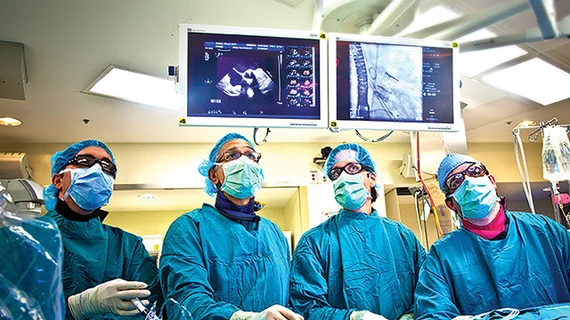CMS is taking public comments ahead of a Medicare Evidence Development and Coverage Advisory Committee (MEDCAC) meeting July 25 in which panelists will discuss procedural volume requirements for centers to begin and maintain a transcatheter aortic valve replacement (TAVR) program.
“The MEDCAC will specifically focus on appraisal of the state of evidence for surgical aortic valve replacement (SAVR), TAVR, percutaneous coronary intervention (PCI) and other relevant structural heart disease procedural volume requirements,” CMS’s meeting announcement stated.
Panelists will rate their confidence levels from 1 to 5 about whether volume requirements are necessary for hospitals, cardiovascular surgeons and interventional cardiologists performing these procedures. They will also be asked if procedural thresholds “outweigh the harms of limiting access to TAVR to only hospitals that meet volume requirements,” and discuss whether the requirements create unintended barriers for certain patients who may benefit from TAVR.
Under the current national coverage decision (NCD) implemented in 2012, criteria to have a TAVR program include:
- At least 50 aortic valve replacements (AVRs) in the year before a TAVR program is launched, including at least 10 AVRs in high-risk patients.
- 1,000 catheterizations per year, including at least 400 PCIs per year, to start and maintain a program.
- At least two physicians with cardiac surgery capabilities, including one who has performed at least 100 career AVRs, 25 AVRs in one year or 50 AVRs in two years.
- An interventional cardiologist who has performed at least 100 structural heart disease procedures overall or 30 left-sided structural procedures per year.
- Once a program is started, an interventional cardiologist and a surgeon must perform a combined 20 AVRs in a single year or 40 over a two-year span to continue the program.
Other stipulations of the programs include participation in a national prospective registry and only performing off-label TAVRs within clinical studies that have been approved by CMS.
The MEDCAC meeting is part of CMS’s process for reconsidering the 2012 NCD.
“By voting on specific questions, and by their discussions, MEDCAC panel members will advise CMS on procedural volume requirements for hospitals and heart team members with both new and continuing TAVR programs that treat Medicare beneficiaries,” the CMS announcement stated. “MEDCAC panels do not make coverage determinations, but CMS benefits from their advice.”

